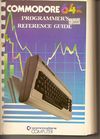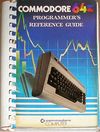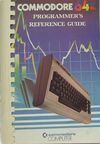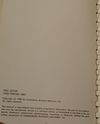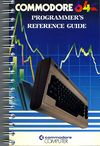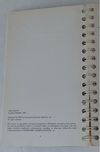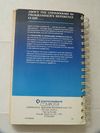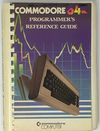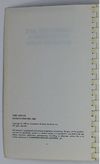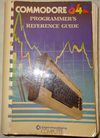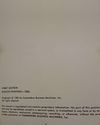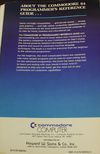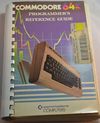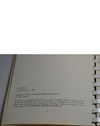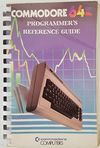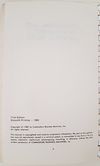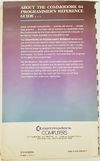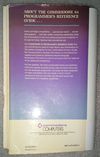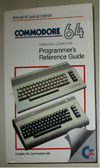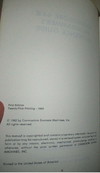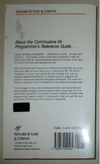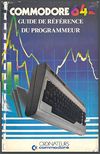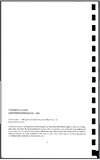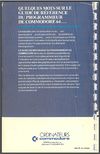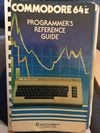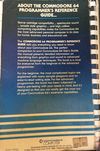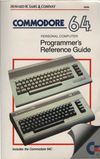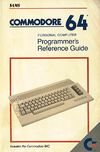Commodore 64 Programmer's Reference Guide
| Commodore 64 Programmer's Reference Guide | |||
|---|---|---|---|
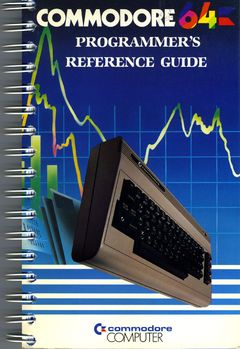 |
Language | English (American) | |
| Author(s) | Commodore Business Machines, Inc. | ||
| Publisher | Howard W. Sams & Co. Inc | ||
| Year | 1982 | ||
| ISBN | ISBN 0-672-22056-3 | ||
| Original price | USD, 19.95, GBP 9.95 | ||
| Media | {{{Media}}} | ||
| Pages | 504 | ||
| Last Edition | First Edition Fourth Printing (1983) | ||
| Genre | Programming Guide | ||
| Information | |||
Back Cover[edit | edit source]
ABOUT THE COMMODORE 64 PROGRAMMER'S REFERENCE GUIDE... |
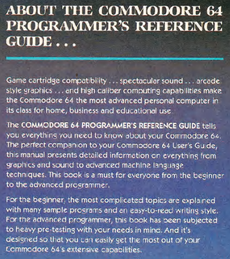 |
Table of Contents (Abridged)[edit | edit source]
This table of contents has been reproduced to include only the chapter and appendix headings, along with the first-level section headings. The original has second-level section headings.
TABLE OF CONTENTS
INTRODUCTION ................................................... ix
o What's Included? .......................................... x
o How to Use This Reference Guide ........................... xi
o Commodore 64 Applications Guide ........................... xii
o Commodore Information Network ............................. xvii
1. BASIC PROGRAMMING RULES ..................................... 1
o Introduction .............................................. 2
o Screen Display Codes (BASIC Character Set) ................ 2
o Programming Numbers and Variables ......................... 4
o Expressions and Operators ................................. 9
o Programming Techniques .................................... 18
2. BASIC LANGUAGE VOCABULARY ................................... 29
o Introduction .............................................. 30
o BASIC Keywords, Abbreviations, and Function Types ......... 31
o Description of BASIC Keywords (Alphabetical) .............. 35
o The Commodore 64 Keyboard and Features .................... 93
o Screen Editor ............................................. 94
3. PROGRAMMING GRAPHICS ON THE
COMMODORE 64 ................................................ 99
o Graphics Overview ......................................... 100
o Graphics locations ........................................ 101
o Standard Character Mode ................................... 107
o Programmable Characters ................................... 108
o Multi-Color Mode Graphics ................................. 115
o Extended Background Color Mode ............................ 120
o Bit Mapped Graphics ....................................... 121
o Multi-Color Bit Map Mode .................................. 127
o Smooth Scrolling .......................................... 128
o Sprites ................................................... 131
o Other Graphics Features ................................... 150
o Programming Sprites-Another Look .......................... 153
4. PROGRAMMING SOUND AND MUSIC
ON YOUR COMMODORE 64 ........................................ 183
o Introduction .............................................. 184
o Using Multiple Voices ..................................... 187
o Changing Waveforms ........................................ 192
o The Envelope Generator .................................... 196
o Filtering ................................................. 199
o Advanced Techniques ....................................... 202
o Synchronization and Ring Modulation ....................... 207
5. BASIC TO MACHINE LANGUAGE ................................... 209
o What is Machine Language? ................................. 210
o How Do You Write Machine Language Programs? ............... 214
o Hexadecimal Notation ...................................... 215
o Addressing Modes .......................................... 221
o Indexing .................................................. 223
o Subroutines ............................................... 228
o Useful Tips for the Beginner .............................. 229
o Approaching a Large Task .................................. 230
o MCS6510 Microprocessor Instruction Set .................... 232
o Memory Management on the Commodore 64 ..................... 260
o The KERNAL ................................................ 268
o KERNAL Power-Up Activities ................................ 269
o Using Machine Language From BASIC ......................... 307
o Commodore 64 Memory Map ................................... 310
6. INPUT/OUTPUT GUIDE .......................................... 335
o Introduction .............................................. 336
o Output to the TV .......................................... 336
o Output to Other Devices ................................... 337
o The Game Ports ............................................ 343
o RS-232 Interface Description .............................. 348
o The User Port ............................................. 359
o The Serial Bus ............................................ 362
o The Expansion Port ........................................ 366
o Z-80 Microprocessor Cartridge ............................. 368
APPENDICES ..................................................... 373
A. Abbreviations for BASIC Keywords ........................ 374
B. Screen Display Codes .................................... 376
C. ASCII and CHR$ Codes .................................... 379
D. Screen and Color Memory Maps ............................ 382
E. Music Note Values ....................................... 384
F. Bibliography ............................................ 388
G. VIC Chip Register Map ................................... 391
H. Deriving Mathematical Functions ......................... 394
I. Pinouts for Input/Output Devices ........................ 395
J. Converting Standard BASIC Programs to
Commodore 64 BASIC .................................... 398
K. Error Messages .......................................... 400
L. 6510 Microprocessor Chip Specifications ................. 402
M. 6526 Complex Interface Adapter (CIA)
Chip Specifications ................................... 419
N. 6566/6567 (VIC-II) Chip Specifications .................. 436
0. 6581 Sound Interface Device (SID) Chip Specifications ... 457
P. Glossary ................................................ 482
INDEX .......................................................... 483
COMMODORE 64 QUICK REFERENCE CARD .............................. 487
SCHEMATIC DIAGRAM OF THE COMMODORE 64 .......................... 491
Extract[edit | edit source]
Page 210:
WHAT IS MACHINE LANGUAGE? At the heart of every microcomputer, is a central microprocessor. It's a very special microchip which is the "brain" of the computer. The Commodore 64 is no exception. Every microprocessor understands its own language of instructions. These instructions are called machine language instructions. To put it more precisely, machine language is the ONLY programming language that your Commodore 64 understands. It is the NATIVE language of the machine.
Schematic Diagram[edit | edit source]
A 370mm x 500mm double-sided fold-out schematic diagram is included in the book. It identified all the ICs and circuit pathways between the power supply, components and external connections (such as the user port, expansion port and serial bus).
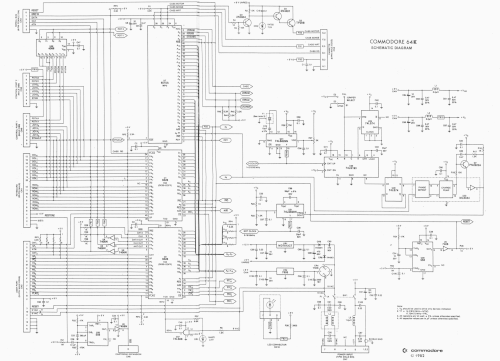 |
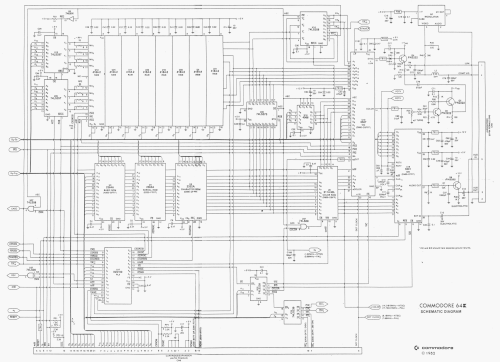 |
Versions[edit | edit source]
Reviews[edit | edit source]
Amazon Customer[7]: "Once you have exhausted the user guide for the C64, this is your next step. It will give you all the information you require to get started with machine code. It also explains how to make use of all the ports on the C64. It is possible to use ( or build) a serial interface to hook up to a regular PC. I found the information on the User Port particularly useful for home automation and robotics."
Jodigi: "A very good and helpful book for advanced programmers learn more basics and technical details about the C64 and also special programming knowledge, but not enough."
Charliefourzero: "It is hard to see how anyone could program the C64 without having read this book. Where the C64 User Guide helps you turn on the computer, this book helps you understand how it works. It should be the bedrock for understanding the C64 both from a software and hardware perspective. It is not perfect, but then CBM honestly did not know exactly how the C64 would be used by its hardcore fans. The book covers all the main areas in sufficient detail; which required at least 500 pages! Simply, a 'must read'.
Links[edit | edit source]
- Commodore 64 Programmer's Reference Guide (Text Version) at zimmers.net, accessed 27 September 2014
- Commodore 64 Programmer's Reference Guide (HTML Version), accessed 27 September 2014
- Commodore 64 Programmer's Reference Guide (PDF Version), accessed 27 September 2014
- Commodore 64 Programmer's Reference Guide in chapters (PDF) at commodore.ca, accessed 30 September 2014
References[edit | edit source]
- ↑ Amazon.com,accessed 27 September 2014
- ↑ Commodore Computers,accessed 27 September 2014
- ↑ Amazon.com,accessed 27 September 2014
- ↑ Amazon.com,accessed 27 September 2014
- ↑ Amazon.com,accessed 27 September 2014
- ↑ Amazon.com,accessed 27 September 2014
- ↑ Amazon Customer Review, accessed 27 September 2014
